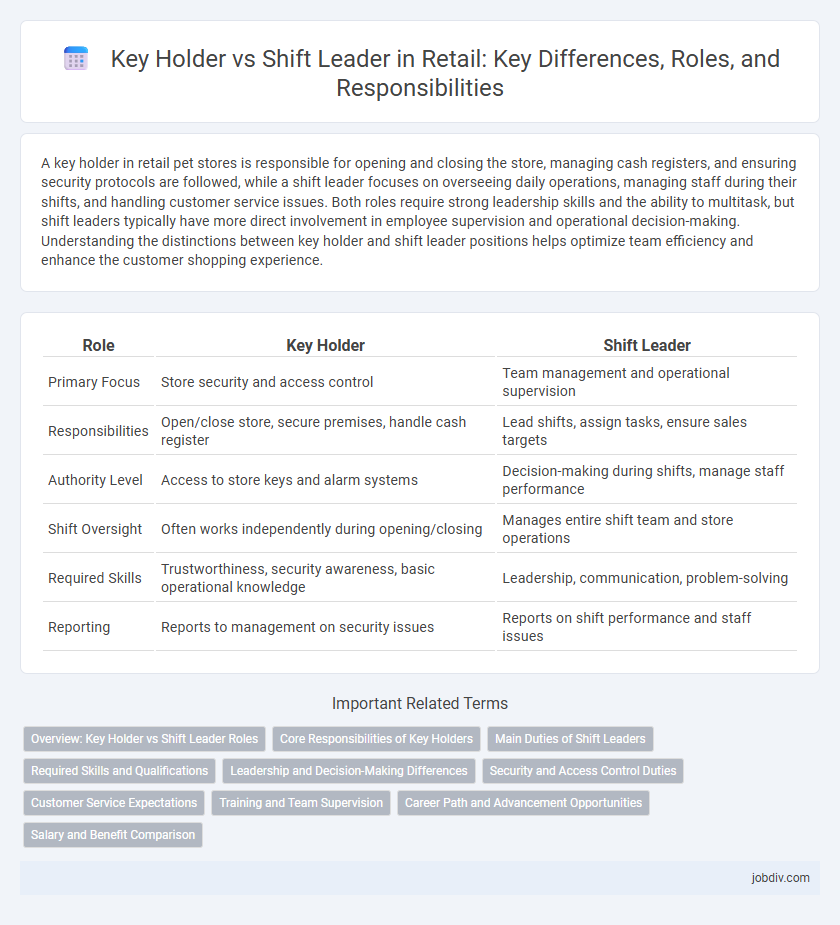A key holder in retail pet stores is responsible for opening and closing the store, managing cash registers, and ensuring security protocols are followed, while a shift leader focuses on overseeing daily operations, managing staff during their shifts, and handling customer service issues. Both roles require strong leadership skills and the ability to multitask, but shift leaders typically have more direct involvement in employee supervision and operational decision-making. Understanding the distinctions between key holder and shift leader positions helps optimize team efficiency and enhance the customer shopping experience.
Table of Comparison
| Role | Key Holder | Shift Leader |
|---|---|---|
| Primary Focus | Store security and access control | Team management and operational supervision |
| Responsibilities | Open/close store, secure premises, handle cash register | Lead shifts, assign tasks, ensure sales targets |
| Authority Level | Access to store keys and alarm systems | Decision-making during shifts, manage staff performance |
| Shift Oversight | Often works independently during opening/closing | Manages entire shift team and store operations |
| Required Skills | Trustworthiness, security awareness, basic operational knowledge | Leadership, communication, problem-solving |
| Reporting | Reports to management on security issues | Reports on shift performance and staff issues |
Overview: Key Holder vs Shift Leader Roles
Key Holders are responsible for securing the store by managing opening and closing procedures, handling keys, and supporting daily operational tasks, while Shift Leaders oversee team performance, delegate responsibilities, and ensure customer service standards during their shift. Both roles require strong leadership skills, but Shift Leaders typically have broader supervisory duties and a greater focus on team management and problem-solving. Understanding these distinctions helps retail businesses optimize store operations and staff efficiency.
Core Responsibilities of Key Holders
Key Holders are responsible for opening and closing the store, managing cash deposits, and ensuring security protocols are followed during their shift. They oversee daily operational tasks such as supervising team members, handling customer service escalations, and maintaining inventory accuracy. Unlike Shift Leaders, Key Holders typically have access to store keys and alarm codes, granting them additional security and administrative responsibilities within retail environments.
Main Duties of Shift Leaders
Shift Leaders in retail oversee daily store operations, manage staff schedules, and ensure customer service standards are met, distinguishing them from Key Holders who primarily secure the premises. They handle conflict resolution, supervise transactions, and drive team performance to meet sales targets. Shift Leaders also train new employees and coordinate with store management for inventory control and loss prevention.
Required Skills and Qualifications
Key Holder roles require strong customer service skills, basic cash handling experience, and reliability in opening or closing the store, with a focus on maintaining operational standards. Shift Leaders must demonstrate advanced leadership abilities, including team management, conflict resolution, and scheduling expertise, along with a deep understanding of store policies and sales targets. Both positions benefit from excellent communication, problem-solving capabilities, and prior retail experience, but Shift Leaders typically need formal supervisory training or proven leadership roles.
Leadership and Decision-Making Differences
Key Holders primarily focus on supervising opening and closing procedures with limited decision-making authority, ensuring store security and operational compliance. Shift Leaders hold broader leadership roles, managing staff schedules, resolving customer issues, and making real-time decisions to maintain smooth daily operations. The distinction lies in Shift Leaders' enhanced responsibility for team management and strategic problem-solving compared to the more task-specific oversight of Key Holders.
Security and Access Control Duties
Key Holders in retail are primarily responsible for opening and closing stores, managing alarm systems, and ensuring secure access to restricted areas. Shift Leaders oversee daily operational tasks but typically do not hold the same security clearance or access privileges as Key Holders. Both roles contribute to store security, but Key Holders have heightened access control duties critical for loss prevention and emergency protocols.
Customer Service Expectations
Key holders in retail are responsible for opening and closing the store, managing cash handling, and providing direct customer service support during their shifts. Shift leaders oversee team performance and ensure smooth daily operations, emphasizing high standards of customer service and resolving escalated issues promptly. Both roles require strong communication and problem-solving skills to maintain excellent customer experiences and uphold store policies.
Training and Team Supervision
Key Holders typically receive targeted training on store opening and closing procedures, cash handling, and emergency protocols, enabling them to secure the premises independently. Shift Leaders undergo comprehensive leadership training that emphasizes effective team supervision, conflict resolution, and performance management to ensure smooth operations during their shifts. Both roles require strong communication skills, but Shift Leaders are primarily responsible for guiding team members and maintaining productivity on the sales floor.
Career Path and Advancement Opportunities
Key Holders typically manage opening and closing store responsibilities, gaining foundational operational knowledge essential for advancement. Shift Leaders oversee entire team operations during their shifts, developing leadership skills that directly translate to store management roles. Progression from Key Holder to Shift Leader often represents a critical step in retail career paths, offering increased responsibilities and preparing employees for assistant manager or store manager positions.
Salary and Benefit Comparison
Key holders in retail typically earn a base salary ranging from $12 to $16 per hour, with benefits including limited paid time off and employee discounts. Shift leaders command higher wages, often between $15 and $20 per hour, accompanied by enhanced benefits such as performance bonuses, additional paid leave, and leadership training programs. Understanding these salary and benefit differences aids employees in making informed career advancement decisions within retail management.
Key Holder vs Shift Leader Infographic

 jobdiv.com
jobdiv.com